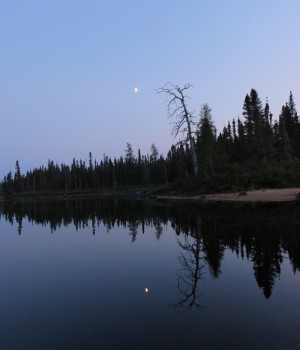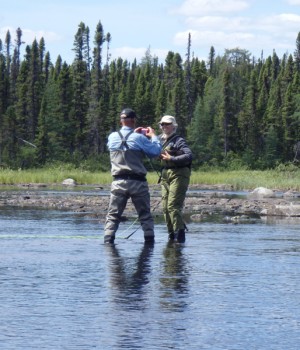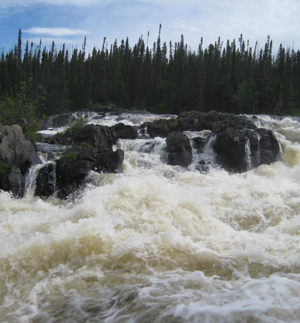Here’s a selection of our favorite images from so far this season at Anne Marie Lodge. Click to view larger image.
Category Archives: Minipi Ecosystem
Wide Open Spaces – Minipi from the Artist’s persepctive
Well known painter, carver and guide Perry Munro describes Minipi as the ideal place for ‘journey people.’ Our web manager interviewed Munro after his stay at Anne Marie Lodge and learned about what entices him to paint the scenes of Minipi.
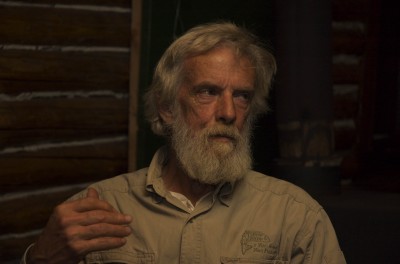 What first brought you to Minipi?
What first brought you to Minipi?
I had no idea what I was first getting into. It was back in the mid 80s, I came up as part of a learning experience on availability of product for a company. I came up and fell in love with the place, been here pretty well off and on ever since.
Do you have a favorite spot on the Minipi watershed?
Well of course there’s always Lover Boy. The fish are there, it’s a pretty spot. I love the depth of the terrain. I’ve painted it and I’ve done sketches of it. It goes back through the different mountains of charcoal all the way back, gives a nice look to it. Lover Boy has a nice feel to it, it shows the Big Land, the space, the openness.

Is there anything in particular you look for when painting Landscapes? What caught your eye at Minipi?
Depth. The space. The space that you exist in. I don’t very often do a tight sketch of Minipi, things are usually big and open. There are journey people and there are destination people: There are people that come here to the big country, to Labrador, to catch the big fish. That’s what they want to do, 8 pounders! And they’re there – but they don’t come easy and they don’t come to everybody. People who get the most out of a trip to Labrador and to Minipi Camps is the person who comes with their eyes wide open. The journey people. They see the flowers, the beaver house…the merganser going by with 17 little chicks.
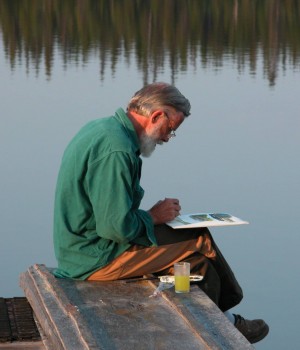 Do you have a favorite memory from your time at our Lodges?
Do you have a favorite memory from your time at our Lodges?
There’s so many events. One time I took off and went to Johnny Lake. I went in by myself, I had never been there before and I had a wonderful day in there. I remember that being kind of a special day. You always feel that sense of being one on your own in here. Jack, Lorraine and Rob have been very kind to me and have given me opportunities to feel that over the years. I can explore and I can paint and do sketches on my own without the guide, I can go and just enjoy the terrain. Sometimes it’s a slow process.
Minipi is largely about big brook trout, but do you have any words for fellow artists who might want to visit?
Sunsets. Sunsets and sunrises. Probably the most over-painted, over-photographed things in the world – but they are beautiful up there. If you’re fortunate enough you can get a chance to see the northern lights. Just sky. Sky and water. It’s just sometimes it feels like being on the prairies; it’s huge. Flying into (the lodge) you get a feeling about the last ice age when it scoured Labrador, all the lakes run the same direction. If you want to travel east to west on foot you’d be forever to get a mile. It’s a landscape that you don’t often see and it’s very wild. I’ve often said that we should thank the outfitters like Jack, Lorraine and Rob for providing this environment because without their foresight in having these places that we can go to we’d never see them. The Coopers’ take care of their guests and they do a good job – they’re working in a very harsh environment trying to logistically manage this whole event of your time you spend with them – the airport pickup, the behind the scenes, the toilet paper being loaded in the plane, there’s so much going on that you don’t see to make sure that your time there is wonderful. For you. Next week there’s somebody else, but for right now, it’s you.
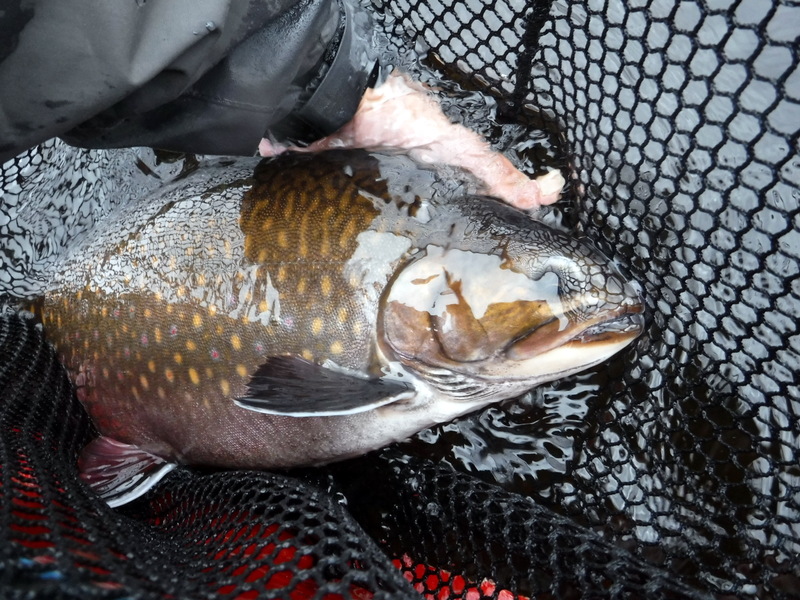
This brookie is one Perry caught while visiting Anne Marie Lodge in mid-July. Perry said he did not weigh this trout, nor did he remove it from the water besides to take this photo. As you can see by comparing Perry’s hand to the trout, the trout is quite large! We’re left to ponder if this trout would break our records.
A Walk to the Falls
It isn’t far from Minipi Lake Lodge to the Falls, but it’s a most interesting ramble. There’s a lot to see and learn here about this northern black spruce ecosystem. Just keep your eyes open and listen to your guide.
 This is a landscape shaped by fire, something that becomes obvious as soon as you set off across the sandy hills by the Lodge. There are hardly any spruce here. The low-growing, bushy northern birch is the dominant plant with patches of blueberry and caribou lichen interspersed. Look for bear, wolf and moose tracks in the damper sections. A fire burned through here in 1950, the result of a plane crash visible just to the west. This wasn’t a very big burn but was large enough to create an open strip that helped as a firebreak to hold back a much larger fire in 1999.
This is a landscape shaped by fire, something that becomes obvious as soon as you set off across the sandy hills by the Lodge. There are hardly any spruce here. The low-growing, bushy northern birch is the dominant plant with patches of blueberry and caribou lichen interspersed. Look for bear, wolf and moose tracks in the damper sections. A fire burned through here in 1950, the result of a plane crash visible just to the west. This wasn’t a very big burn but was large enough to create an open strip that helped as a firebreak to hold back a much larger fire in 1999.
As you climb, you enter the more recent burn. There are lots of dead standing trunks and fallen, twisted logs and stumps. Northern birch and blueberries have begun to fill in along with the white-flowered, leathery Labrador tea and Kalmia (sheep’s laurel). There are patches of an attractive little lichen called “British soldiers”, certainly a reference to the ranks of characteristic small red growths that form the plant. There are many kinds of berries too. In one sandy hollow the trail goes past several magnaberry or whiteberry plants. These red-stemmed vines spread over an area of a square meter or more, and are quite distinctive and attractive.
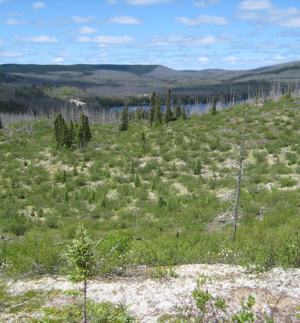 From the height of land through the burnt forest you can see the full extent and impact of the 1999 fire. Probably started by lightning, it came from the west and traveled more than 30 miles across the hills before dying out a few miles to the east on the shores of Minipi Lake. It took a valiant effort to save the Lodge. Water bombers, professional forest fire fighters, and Minipi guides all played a role in that. Here and there you can still find holes where they had to dig out smoldering hot spots that remained in the fire’s wake.
From the height of land through the burnt forest you can see the full extent and impact of the 1999 fire. Probably started by lightning, it came from the west and traveled more than 30 miles across the hills before dying out a few miles to the east on the shores of Minipi Lake. It took a valiant effort to save the Lodge. Water bombers, professional forest fire fighters, and Minipi guides all played a role in that. Here and there you can still find holes where they had to dig out smoldering hot spots that remained in the fire’s wake.
Though the track of the fire is evident everywhere you look, unburned stands of spruce and balsam fir can also be seen. This forest was protected in large part by its locally damper surroundings in bogs and river valleys. These stands are the source of seedlings that will eventually re-forest the burned over areas. But it takes along, long time.
The path comes into a major unburned region as you begin to descend into the Minipi River valley. The river here, the outlet of the Minipi system, has cut through a rocky ridge to form a series of strong rapids and falls that leads to the deep gorge. Sand substrate gives way to moss-covered scree. The growth is luxuriant and the forest is thick, no doubt fed by springs through the rocks from the sand above. Mind your step on the 200’ descent. Things can be slippery.
 The flora here is very different. There are ferns, trout lilies, bakeapples (a tiny golden raspberry) and the ubiquitous sphagnum moss. In one small flat area we came across a patch of horsetails, an ancient plant that harks back to the Carboniferous era.
The flora here is very different. There are ferns, trout lilies, bakeapples (a tiny golden raspberry) and the ubiquitous sphagnum moss. In one small flat area we came across a patch of horsetails, an ancient plant that harks back to the Carboniferous era.
And then there’s the Falls. The entire Minipi watershed drains across this set of impressive rocky ledges. Despite the overall strength of the cataract it is possible to pick out little side channels and steps in the rock where leaping fish might ascend. But it is probably unlikely that fish from below the Falls contribute much to the populations of the lakes and short river sections of the Minipi system proper. If that happened regularly, we might expect ouananiche (landlocked Atlantic salmon) to appear in the watershed, but they never have.
Still we hardly know anything about the fauna and ecology of the river below the region of the Falls. That’s a story that will have to remain for some future time.


